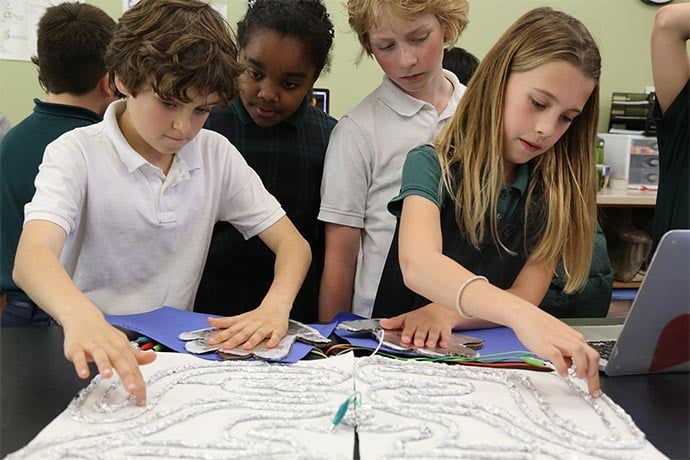I’m a big advocate for Makey Makey in the classroom, because — as their byline suggests — it’s truly an invention kit for anyone. Unfortunately, I’ve lately read some negative feedback about this simple board, and I feel the urge to defend its use; some write that it’s far too simple to offer any educational value.
Certainly if we use their very fun and playful marketing video as the instructor’s manual, a Makey Make is a simple kit toy. Yes, anyone can wire a few bananas, load a piano on the cloud, and riff on Twinkle Twinkle. A musical staircase is novel too, and who doesn’t like the idea of playing Dance Dance barefoot in the forest, as the video suggests?
I’ve seen just as many cardboard furniture projects, Caine’s Arcade doppelgängers, and recycled art projects as I have critiques of the simple Makey Makey circuit board. But, all the device’s beauty lies within its simplicity: When we show budding inventors that it may replace your everyday input/output hardware, can register a keystroke by literally completing a circuit, and is “plug and play” with any even slightly conductive material, the opportunities unfold.
Any seasoned technology integrationist knows there is danger in building the project around the tool. But, sometimes you can wrap a larger idea around the potential of a device. For example, we’re using Lego Mindstorms to ask students to prototype robots that serve humanitarian needs. That same marriage of technology opportunity and real-world need led to our Living Room project.
Inspired partly by Austin’s TEDxYouth and Hackidemia’s interactive play space in 2013, we challenged our grade 8 students to conceptualize, design and develop a living room, alive with interactive exhibits that elementary level students could interact with. At the culmination of this 6-8 week project, students’ exhibits would be evaluated by their audience, which would consist of visitors aged from 8 to adult.
How can we design and implement an interactive exhibit to serve younger students’ desire to play? This was a driving question that demanded a few constraints and guidelines:
- The project’s underlying melody was one of design thinking and the engineering process, so that we had a familiar foundation to follow.
- A design and inventory template allowed students to draw and diagram their plans. This also helped them communicate supplies they would need.
- Core elements of the project included audience analysis and exhibit design, with an emphasis on efficient online research (analyzing articles about ideal museum and interactive exhibit design, and utilizing those practices in their creations).
- Students also learned about copyright and fair use as they searched for sounds. Many created their own with GarageBand, and SoundPlant was another go-to application.
- A sense of mystery was key to this exhibit. Students concealed all mechanics (wires, MakeyMakey, speakers etc.) of their designs, forcing visitors to wonder and imagine.
- Simplicity was also paramount. Each exhibit would have instructions as simple as “Step on the foil, and play the flowers.”
Like all our STEM and PBL units, students were provided a clear and concise rubric, so students could understand their tasks and targets.
For one afternoon, the Grade 8 students opened the doors to their younger peers to come play. Entire classes came to visit, while the inventors could observe from a distance and learn what worked well – and what didn’t. In closing discussions, these exhibit engineers had the opportunity to discuss topics like user interface and design cycles, and empathy during audience analyses.

All of this from cardboard, lots of duct tape and glue, an assortment of conductive materials (think aluminum, flowers, graphite) and a simple inventor’s kit called the MakeyMakey.
To quote one of the Grade 8 kids — How can learning be so ridiculously hard and fun at the same time?
Learn More
TEDxYouth@Austin + Hackidemia
https://youtu.be/jdE56KYXZz8
http://www.hackidemia.com/blog/tedxyouthaustin-hackidemia-the-musical-room
Makey Makey
Garage Band (Mac)
http://www.apple.com/mac/garageband/
https://itunes.apple.com/us/app/garageband/id682658836?mt=12&ls=1
Soundplant (Windows, Mac)
Example Projects
https://www.youtube.com/watch?v=wkPt9MYqDW0
https://www.youtube.com/watch?v=STHZ2FFKYBs
https://www.youtube.com/watch?v=4KEEqZgFVsg

